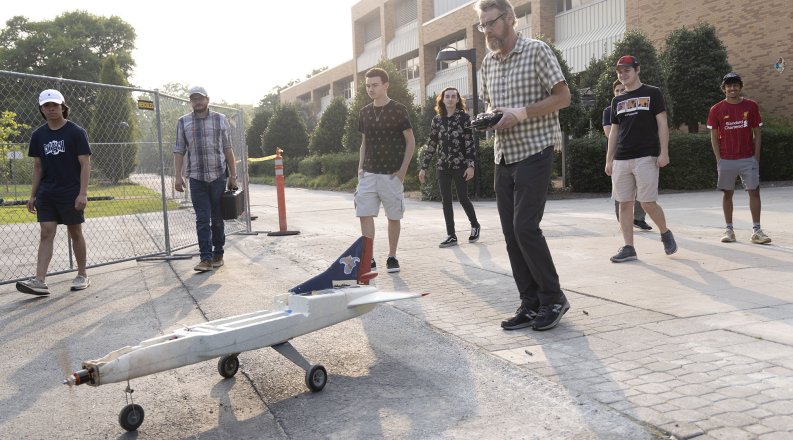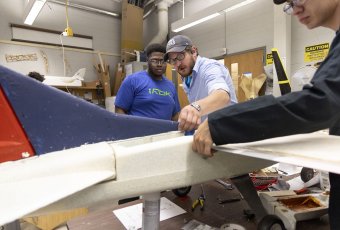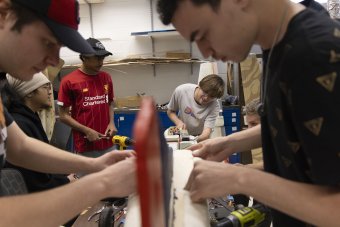A 1980s-era radio-controlled plane used for U.S. Army surface-to-air gun and missile target practice is getting a new life at Old Dominion University’s Unmanned and Autonomous Vehicle Laboratory.
Over the summer, more than a dozen students refurbished and retrofitted the 40-year-old radio-controlled plane with autonomous technology.
In the 1970s and ‘80s, the U.S. Army purchased 100,000 model airplanes, known as radio-controlled miniature aerial targets (RCMATs), designed as target practice for surface-to-air guns and missiles.
The FQM-117B, the model the students are refurbishing, is a 6-foot foam plane, resembling a 1/9th-scale Soviet MiG-27 jet fighter. With a two-stroke gasoline engine, it can top 90 mph, climb to 10,000 feet and stay airborne for 12 minutes.
Because the models were made to be expendable, they came in a kit with spare parts. One person would launch the model by hand, then the radio controller would take over. Once the target was hit, the airplane would be retrieved and repaired with the spare parts to be sent back out into the field.
The FQM-117C, a 1/9th-scale model of the F-16 Fighting Falcon, was later used in conjunction with the B-Model for “Friend or Foe” training.
The series was retired in the late 1990s, and many of the airframes ended up at NASA Langley Research Center for use as testbeds for flight control systems.
How the airplanes got to Old Dominion is another story.
Rob Stuart, a graduate student in the Department of Mechanical and Aerospace Engineering, attended an Association for Uncrewed Vehicle Systems International meeting a few years ago. During a break between sessions Mike French, vice president of Space Systems at Aerospace Industries Association, showed him the airframe of an RCMAT stowed in the back of his car.
French, who has a long history with NASA Langley, knew that they were clearing out these models. He suggested that Stuart, who is involved in advising a variety of UAV-related student clubs and design projects, might find some use for them.
The 6-foot RCMAT went home in the back of Stuart’s truck that day.
It didn’t end there.
“I came home one day, and Mike had dropped off 10 more of them in front of my garage door,” Stuart said. “And then, three days later, there's another 10 of them.”
Stuart had the idea to modernize the airplanes and provide undergraduate students with an opportunity to get hands-on experience in working with autonomous systems.
“They're pretty much the way that the Army would have received them in the early 1980s,” Stuart said. “The project provides a great opportunity to bring old and new together.”
With the help of Shane Berry, a physics major with an interest in low-speed aerodynamics and small UAVs, Stuart received a Virginia Space Grant Consortium Innovative Projects grant to improve the RCMAT’s aerodynamics and add autonomous systems.
Stuart then reached out to a group of students from a previous aircraft design project.
Twice a week, more than a dozen of those student volunteers showed up at the lab to work on the models.
They have been doing everything from trimming balsa wood and cutting foam to 3D printing and computer coding for the autonomous systems.
One group of students modified a detachable wing section to address the RCMAT’s low-speed handling issues.
They also adapted the airframe to accept an electric motor – the equivalent of a 2.5 horsepower gas engine.
“An important lesson learned has been the difference between gas-powered versus electric and how that changes flight dynamics,” Stuart explained.
The addition of autonomous systems and sensors will complete the project. “The goal is to flip the switch and the plane will take off, circle around and land itself with zero intervention,” Stuart said.
Stuart and Drew Landman, professor in the Department of Mechanical and Aerospace Engineering and faculty advisor on the project, recently took one of the completed UAVs out to an airfield for testing.
The airplane, equipped with a small autopilot and sensors, was programmed for a test flight. It took off, flew autonomously and landed on its own. The landing, however, wasn’t so smooth. The airplane needed minor repairs afterward.
Stuart suggests that failure, though, is a good lesson.
“When students go to build the real thing in the workforce, they will have already had a chance to fail,” he said. “At least once, they will have had the opportunity to crash and have some sort of setback.
“It allows for big mistakes to be made because we have more of them,” he added. “It gets it out of the way early.”





